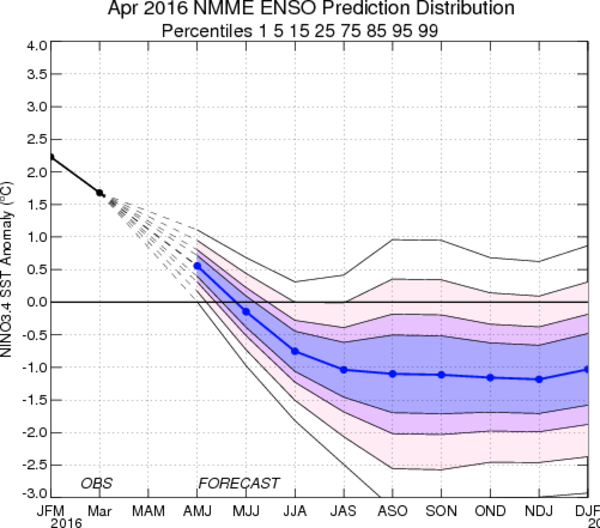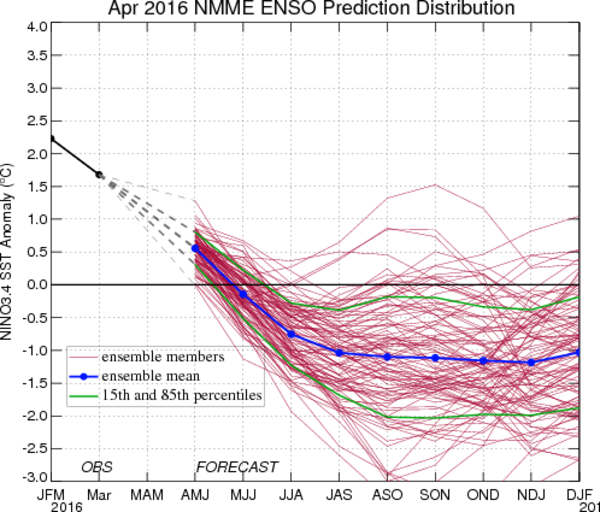IRI ENSO Forecast
IRI Technical ENSO Update
Published: April 21, 2016
Note: The SST anomalies cited below refer to the OISSTv2 SST data set, and not ERSSTv4. OISSTv2 is often used for real-time analysis and model initialization, while ERSSTv4 is used for retrospective official ENSO diagnosis because it is more homogeneous over time, allowing for more accurate comparisons among ENSO events that are years apart. During ENSO events, OISSTv2 usually shows stronger anomalies than ERSSTv4, and during very strong events the two datasets may differ by as much as 0.5 C.
Recent and Current Conditions
After having been at a strong El Niño level since around mid-July 2015, the weekly SST anomaly in the NINO3.4 region recently dropped below 1.5 C during early April. For March 2016 the average NINO3.4 SST anomaly was 1.68 C, indicative of strong El Niño conditions, and for Jan-Mar it was 2.23 C. The IRI’s definition of El Niño, like NOAA/Climate Prediction Center’s, requires that the SST anomaly in the Nino3.4 region (5S-5N; 170W-120W) exceed 0.5 C. Similarly, for La Niña, the anomaly must be -0.5 C or less. The climatological probabilities for La Niña, neutral, and El Niño conditions vary seasonally, and are shown in a table at the bottom of this page for each 3-month season. The most recent weekly SST anomaly in the Nino3.4 region was 1.3 C, in the category of moderate El Niño. Accompanying this SST has been a continuing but weakening El Niño-like atmospheric pattern, including westerly low-level wind anomalies and positive anomalies of convection near and just east of the dateline. The Southern Oscillation Index (SOI) and the equatorial SOI have also been negative, but less strongly so than in recent months, indicating continuing but weakening El Niño conditions.
Expected Conditions
What is the outlook for the ENSO status going forward? The most recent official diagnosis and outlook was issued one week ago in the NOAA/Climate Prediction Center ENSO Diagnostic Discussion, produced jointly by CPC and IRI; it called for this strong El Niño to continue weakening, and return to neutral by late spring or early summer 2016, with about a 65% possibility for La Niña development by fall and 70% for the existence of La Niña during mid-fall. The latest set of model ENSO predictions, from mid-April, now available in the IRI/CPC ENSO prediction plume, is discussed below. Currently, while the most recent Nino3.4 SST anomalies are still in the moderate El Niño category, subsurface temperature anomalies across the eastern equatorial Pacific have cooled substantially over the last few months and are now somewhat below average. With these below-average subsurface temperatures, the SST is poised to continue retreating toward average and then likely below average in the coming few months. In the atmosphere, the basin-wide sea level pressure anomaly pattern (e.g. the SOI) has been at moderate El Niño levels, no longer at strong levels, and with some fairly large week-to-week variations. Anomalous convection (as measured by OLR) has been above average near and somewhat east of the dateline, but more weakly than seen in the previous months, particularly the portion to the east of the dateline. Together, the oceanic and atmospheric features reflect continuing but weakening El Niño conditions for late March through mid-April. By early May, the Niño3.4 anomaly will likely be below 1 C, in the weak category, and later in May it could decrease to the ENSO-neutral range.
As of mid-April, 76% of the dynamical or statistical models models predicts El Niño SST conditions, and 24% predicts neutral conditions for the initial Apr-Jun 2016 season. At lead times of 3 or more months into the future, statistical and dynamical models that incorporate information about the ocean’s observed subsurface thermal structure generally exhibit higher predictive skill than those that do not. For the Jul-Sep 2016 season, among models that do use subsurface temperature information, 50% predicts ENSO-neutral conditions, and 50% predicts La Niña conditions. For all model types, the probabilities for El Niño are greater than 50% only for Apr-Jun, and drop to about 30% by May-Jul, 20% for Jun-Aug, and less than 10% for the remainder of the seasons through Dec-Feb 2016-17. No model predicts La Niña conditions until May-Jul 2016, when the chance becomes just 12%, but the chances rise to just over 30% by Jun-Aug and to 50% or more beginning in Sep-Nov, reaching about 70% for Oct-Dec through Dec-Feb 2016-17. Chances for neutral ENSO conditions rise to 60% for May-Jul, and then fall back to about 45% for Aug-Oct and Sep-Nov, and then below 30% beginning in Oct-Dec through the remainder of the forecast period.
Note – Only models that produce a new ENSO prediction every month are included in the above statement.
Caution is advised in interpreting the distribution of model predictions as the actual probabilities. At longer leads, the skill of the models degrades, and skill uncertainty must be convolved with the uncertainties from initial conditions and differing model physics, leading to more climatological probabilities in the long-lead ENSO Outlook than might be suggested by the suite of models. Furthermore, the expected skill of one model versus another has not been established using uniform validation procedures, which may cause a difference in the true probability distribution from that taken verbatim from the raw model predictions.
An alternative way to assess the probabilities of the three possible ENSO conditions is more quantitatively precise and less vulnerable to sampling errors than the categorical tallying method used above. This alternative method uses the mean of the predictions of all models on the plume, equally weighted, and constructs a standard error function centered on that mean. The standard error is Gaussian in shape, and has its width determined by an estimate of overall expected model skill for the season of the year and the lead time. Higher skill results in a relatively narrower error distribution, while low skill results in an error distribution with width approaching that of the historical observed distribution. This method shows probabilities for La Niña at near-zero for Apr-Jun 2016, rising to near 50% by Jul-Sep and to near 60% from Oct-Dec 2016 through Dec-Feb 2016-17. Model probabilities for neutral ENSO conditions are about 25% for Apr-Jun, rise to at least 60% for May-Jul and Jun-Aug, and then drop to 40% or less for Aug-Oct through Dec-Feb 2016-17. Probabilities for El Niño are about 75% for Apr-Jun 2016, near 20% for May-Jul, and 10% or less from Jun-Aug through the final season of Dec-Feb 2016-17. A plot of the probabilities generated from this most recent IRI/CPC ENSO prediction plume using the multi-model mean and the Gaussian standard error method summarizes the model consensus out to about 10 months into the future. The same cautions mentioned above for the distributional count of model predictions apply to this Gaussian standard error method of inferring probabilities, due to differing model biases and skills. In particular, this approach considers only the mean of the predictions, and not the total range across the models, nor the ensemble range within individual models.
The probabilities derived from the models on the IRI/CPC plume describe, on average, rapidly decreasing likelihood for El Niño conditions from the initially high levels of the initial Apr-Jun 2016 season. The models indicate a return to neutral ENSO by early summer, and then suggest a likelihood for La Nina development by autumn 2016. A caution regarding this latest set of model-based ENSO plume predictions, is that factors such as known specific model biases and recent changes that the models may have missed will be taken into account in the next official outlook to be generated and issued in early October by CPC and IRI, which will include some human judgement in combination with the model guidance.
Climatological Probabilities
| Season |
La Niña |
Neutral |
El Niño |
| DJF |
36% |
30% |
34% |
| JFM |
34% |
38% |
28% |
| FMA |
28% |
49% |
23% |
| MAM |
23% |
56% |
21% |
| AMJ |
21% |
58% |
21% |
| MJJ |
21% |
56% |
23% |
| JJA |
23% |
54% |
23% |
| JAS |
25% |
51% |
24% |
| ASO |
26% |
47% |
27% |
| SON |
29% |
39% |
32% |
| OND |
32% |
33% |
35% |
| NDJ |
35% |
29% |
36% |

IRI/CPC Mid-Month Model-Based ENSO Forecast Probabilities
| Season |
La Niña |
Neutral |
El Niño |
| AMJ 2016 |
~0% |
24% |
76% |
| MJJ 2016 |
5% |
76% |
19% |
| JJA 2016 |
31% |
61% |
8% |
| JAS 2016 |
47% |
47% |
6% |
| ASO 2016 |
52% |
40% |
8% |
| SON 2016 |
55% |
35% |
10% |
| OND 2016 |
59% |
31% |
10% |
| NDJ 2016 |
60% |
30% |
10% |
| DJF 2016 |
59% |
32% |
9% |





